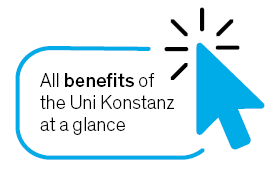


Postdoctoral position in Theoretical Biophysics
(full-time, salary up to E 13 TV-L)
Reference number 2025/160. The expected starting date is 01.01.2026. The position is limited until 31.12.2027.
In principle, this position can be divided into two part-time positions.
We are a Cluster of Excellence within the Excellence Strategy of the German Federal and State Governments.
Being a cooperation between the University of Konstanz and the Max Planck Institute of Animal Behavior, we use the extensive expertise in the region to create an interdisciplinary environment for the study of collective behaviour that is unique worldwide. "The Centre for the Advanced Study of Collective Behaviour" is dedicated to the study of collective behaviour across a variety of species and across different organizational levels. For more information on the Cluster of Excellence, please visit: Collective Behaviour | exc.uni-konstanz.de.
We are seeking a PostDoc with a quantitative background who has finished (or about to finish) a doctoral degree in preferably in physics but other quantitative backgrounds will be considered. The candidate should show enthusiasm for tackling theoretical foundations of biological phenomena and creativity to address difficult research questions. The researcher will be based in the Integrative Biophysics group at the University of Konstanz and Max Planck Institute of Animal Behavior, located in Konstanz, Germany.
The Integrative Biophysics group at the CASCB led by Dr. Ahmed El Hady. The group focuses on a diverse set of theoretical biophysics problems. The PostDoc project can potentially address the following:
1. How can one couple spatial movement dynamics to temporal decision-making process in an analytically tractable model, accounting for environments with different statistical structures?
2. Can social learning in a foraging context be regarded as a statistical learning process?
3. What are the effects of extracellular matrix characteristics and membrane biophysical properties on electromechanical wave propagation in neurons?
4. What are the collective neuronal modes one can derive from coupling electrically driven mechanical waves in single neurons?
Relevant Publications:
Blum Moyse, L., & El Hady, A. (2024). Social patch foraging theory in an egalitarian group. https://doi.org/10.48550/arXiv.2412.02381.
Kilpatrick, Z. P., Davidson, J. D., & El Hady, A. E. (2020). Normative theory of patch foraging decisions. https://doi.org/10.1101/2020.04.22.055558.
El Hady, A., Machta, B. Mechanical surface waves accompany action potential propagation. Nat Commun 6, 6697 (2015). https://www.nature.com/articles/ncomms7697
Your Responsibilities
- Develop and analytically derive models
- Numerical model simulations
- Presenting results at local and international conference
- Writing research papers and other publications
Your Competencies
- Graduate degree (PhD level) in a quantitative field (preferably physics but computer science, applied mathematics, engineering are also considered)
- Strong analytical and mathematical skills
- Relevant experience with stochastic processes and partial differential equations are desired
- Very good communication skills and the ability for teamwork
- Strong written and oral communications skills in English
We Offer
- An interesting and challenging job at the heart of exciting research activities with a unique infrastructure and interdisciplinary research community
- Professional infrastructure and support for conducting research
- Ability to work with world-leading scientists on a new and exciting research field
- High flexibility and independence in organizing your own tasks
- A family-friendly university and work environment that values and promotes diversity and equal opportunities
- Opportunities for individual training and development
- Payment in accordance with the TV-L pay scale (up to TV-L E 13)

Please include the following documents:
1. Research statement (3 – 4 pages) addressing the following prompts:
- Describe your main scientific interests, how they developed, and how they relate to the proposed research project. Explain what scientific questions most motivate you and why. (1 page)
- Describe one or more specific research questions / directions you would be interested to tackle guided by the questions above, and explain how you would go about addressing them (2 – 3 pages)
2. Curriculum vitae (CV)
For more information on the project, please contact Dr. Ahmed El Hady via e-mail: ahmed.el-hady@uni-konstanz.de.
This position is available until filled. For full consideration, please submit your application by 15th September 2025 via our Online Application Portal.
The University of Konstanz is committed to ensuring an environment that provides equal opportunities and promotes diversity, as well as a good balance between university and family life. As an equal opportunity employer, we strive to increase the number of women working in research and teaching. We also support working couples through our dual career programme. Persons with disabilities are explicitly encouraged to apply. They will be given preference if appropriately qualified (contact sbv@uni-konstanz.de, + 49 7531 88-4016).